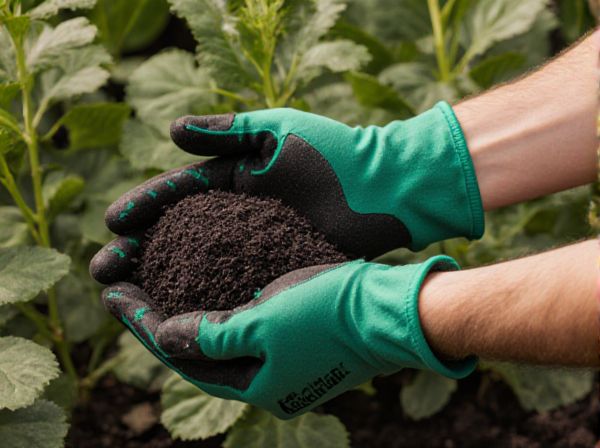
Biochar vs Perlite Illustration
Biochar enhances soil fertility by improving nutrient retention and microbial activity, making it a sustainable soil amendment. Perlite, a volcanic glass, primarily improves soil aeration and drainage without adding nutrients. Combining biochar and perlite can optimize soil structure and nutrient availability for healthier plant growth.
Table of Comparison
| Feature | Biochar | Perlite |
|---|---|---|
| Material Source | Pyrolyzed organic biomass | Volcanic glass, expanded by heating |
| Soil Improvement | Enhances nutrient retention, increases microbial activity | Improves aeration and drainage |
| Water Retention | High water holding capacity | Moderate water retention, promotes rapid drainage |
| pH Impact | Typically neutral to alkaline | Neutral to slightly alkaline |
| Longevity in Soil | Stable for hundreds to thousands of years | Does not degrade, remains inert |
| Cost | Varies; generally medium cost | Generally low to medium cost |
| Best Uses | Improving soil fertility and carbon sequestration | Soil aeration and seed starting mixes |
Introduction to Soil Amendments: Biochar and Perlite
Biochar and perlite are essential soil amendments that enhance soil structure and nutrient retention. Biochar, a carbon-rich product from pyrolyzed organic materials, improves soil fertility and water-holding capacity while reducing greenhouse gas emissions. Perlite, a volcanic glass expanded by heat, increases aeration and drainage, making it ideal for preventing soil compaction and supporting root development.
What Is Biochar?
Biochar is a carbon-rich product obtained from the pyrolysis of organic biomass under limited oxygen conditions, enhancing soil fertility by improving nutrient retention and water-holding capacity. It boosts microbial activity and reduces soil acidity, promoting healthier plant growth. Unlike perlite, which is a volcanic glass used primarily for aeration and drainage, biochar actively enriches the soil's organic matter and carbon content.
What Is Perlite?
Perlite is a volcanic glass that expands when heated, creating lightweight, porous particles widely used in soil conditioning. Its primary function is to improve aeration, drainage, and moisture retention in potting mixes and garden soils. Compared to biochar, perlite does not contribute organic matter but enhances soil structure and root oxygen availability effectively.
Biochar vs Perlite: Key Differences
Biochar and perlite serve distinct roles in soil amendment, with biochar primarily enhancing soil fertility and carbon sequestration through its porous structure and high carbon content, while perlite improves soil aeration and drainage due to its lightweight volcanic glass composition. Biochar's nutrient retention capacity supports microbial activity and long-term soil health, contrasting with perlite's inert nature, which does not provide nutrients but prevents soil compaction. The choice between biochar and perlite depends on specific soil improvement goals, with biochar favored for sustainability and nutrient cycling, and perlite preferred for improving root aeration and moisture control.
Water Retention Comparison
Biochar significantly enhances water retention in soil due to its porous structure, which can hold up to 3-4 times its weight in water, improving moisture availability for plants. Perlite, a volcanic glass, primarily aids in aeration and drainage but has limited water retention capacity compared to biochar. Studies show biochar-amended soils retain 10-20% more water than those supplemented with perlite, especially in sandy or drought-prone soils.
Impact on Soil Aeration
Biochar enhances soil aeration by improving porosity and retaining moisture, which promotes root respiration and microbial activity. Perlite increases soil aeration through its lightweight, porous structure, providing immediate improvement in soil airflow and drainage. Both materials contribute to improved soil aeration, but biochar also adds long-term benefits by enriching soil organic matter.
Effects on Soil Fertility and Microbial Life
Biochar enhances soil fertility by improving nutrient retention, increasing cation exchange capacity, and promoting beneficial microbial activity, leading to a more robust soil ecosystem. Perlite primarily improves soil aeration and drainage but does not contribute nutrients or directly stimulate microbial populations. Incorporating biochar significantly boosts microbial diversity and soil organic matter compared to perlite, which mainly supports physical soil structure.
Environmental Sustainability: Biochar vs Perlite
Biochar enhances environmental sustainability by sequestering carbon and improving soil fertility through increased nutrient retention and microbial activity. Perlite, an inert volcanic glass, primarily aids soil aeration and drainage but does not contribute to carbon storage or nutrient cycling. Utilizing biochar supports long-term carbon sequestration, while perlite's environmental impact is limited to its mining and processing.
Cost and Availability Considerations
Biochar offers a cost-effective soil amendment made from organic waste, often more affordable and accessible in regions with abundant biomass resources, while perlite, a volcanic glass, tends to be pricier due to mining and processing expenses. Availability of biochar is influenced by local biomass and production facilities, whereas perlite is globally distributed but may incur higher shipping costs. Farmers seeking sustainable and economical soil conditioners often prefer biochar for its dual benefits of soil enrichment and carbon sequestration.
Which to Choose: Biochar or Perlite for Your Garden?
Biochar enhances soil fertility by improving nutrient retention, water holding capacity, and microbial activity, making it ideal for long-term soil health and carbon sequestration. Perlite offers excellent aeration and drainage, preventing soil compaction and promoting root development, which is beneficial for container gardening and water-sensitive plants. Selecting between biochar and perlite depends on soil needs; biochar suits nutrient-deficient or degraded soils, while perlite is preferred for improving soil structure and drainage.
Biochar vs Perlite Infographic

 gardendif.com
gardendif.com